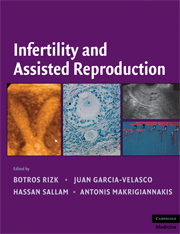Book contents
- Frontmatter
- Contents
- Contributors
- Foreword
- Preface
- Introduction
- PART I PHYSIOLOGY OF REPRODUCTION
- PART II INFERTILITY EVALUATION AND TREATMENT
- 6 Evaluation of the Infertile Female
- 7 Fertiloscopy
- 8 Microlaparoscopy
- 9 Pediatric and Adolescent Gynecologic Laparoscopy
- 10 Laparoscopic Tubal Anastomosis
- 11 Tubal Microsurgery versus Assisted Reproduction
- 12 The Future of Operative Laparoscopy for Infertility
- 13 Operative Hysteroscopy for Uterine Septum
- 14 Laser in Subfertility
- 15 Ultrasonography of the Endometrium for Infertility
- 16 Ultrasonography of the Cervix
- 17 Transrectal Ultrasonography in Male Infertility
- 18 The Basic Semen Analysis: Interpretation and Clinical Application
- 19 Evaluation of Sperm Damage: Beyond the WHO Criteria
- 20 Male Factor Infertility: State of the ART
- 21 Diagnosis and Treatment of Male Ejaculatory Dysfunction
- 22 Ovulation Induction
- 23 Clomiphene Citrate for Ovulation Induction
- 24 Aromatase Inhibitors for Assisted Reproduction
- 25 Pharmacodynamics and Pharmacokinetics of Gonadotrophins
- 26 The Future of Gonadotrophins: Is There Room for Improvement?
- 27 Ovarian Hyperstimulation Syndrome
- 28 Reducing the Risk of High-Order Multiple Pregnancy Due to Ovulation Induction
- 29 Hyperprolactinemia
- 30 Medical Management of Polycystic Ovary Syndrome
- 31 Surgical Management of Polycystic Ovary Syndrome
- 32 Endometriosis-Associated Infertility
- 33 Medical Management of Endometriosis
- 34 Reproductive Surgery for Endometriosis-Associated Infertility
- 35 Congenital Uterine Malformations and Reproduction
- 36 Unexplained Infertility
- 37 “Premature Ovarian Failure”: Characteristics, Diagnosis, and Management
- PART III ASSISTED REPRODUCTION
- PART IV ETHICAL DILEMMAS IN FERTILITY AND ASSISTED REPRODUCTION
- Index
- Plate section
- References
31 - Surgical Management of Polycystic Ovary Syndrome
from PART II - INFERTILITY EVALUATION AND TREATMENT
Published online by Cambridge University Press: 04 August 2010
- Frontmatter
- Contents
- Contributors
- Foreword
- Preface
- Introduction
- PART I PHYSIOLOGY OF REPRODUCTION
- PART II INFERTILITY EVALUATION AND TREATMENT
- 6 Evaluation of the Infertile Female
- 7 Fertiloscopy
- 8 Microlaparoscopy
- 9 Pediatric and Adolescent Gynecologic Laparoscopy
- 10 Laparoscopic Tubal Anastomosis
- 11 Tubal Microsurgery versus Assisted Reproduction
- 12 The Future of Operative Laparoscopy for Infertility
- 13 Operative Hysteroscopy for Uterine Septum
- 14 Laser in Subfertility
- 15 Ultrasonography of the Endometrium for Infertility
- 16 Ultrasonography of the Cervix
- 17 Transrectal Ultrasonography in Male Infertility
- 18 The Basic Semen Analysis: Interpretation and Clinical Application
- 19 Evaluation of Sperm Damage: Beyond the WHO Criteria
- 20 Male Factor Infertility: State of the ART
- 21 Diagnosis and Treatment of Male Ejaculatory Dysfunction
- 22 Ovulation Induction
- 23 Clomiphene Citrate for Ovulation Induction
- 24 Aromatase Inhibitors for Assisted Reproduction
- 25 Pharmacodynamics and Pharmacokinetics of Gonadotrophins
- 26 The Future of Gonadotrophins: Is There Room for Improvement?
- 27 Ovarian Hyperstimulation Syndrome
- 28 Reducing the Risk of High-Order Multiple Pregnancy Due to Ovulation Induction
- 29 Hyperprolactinemia
- 30 Medical Management of Polycystic Ovary Syndrome
- 31 Surgical Management of Polycystic Ovary Syndrome
- 32 Endometriosis-Associated Infertility
- 33 Medical Management of Endometriosis
- 34 Reproductive Surgery for Endometriosis-Associated Infertility
- 35 Congenital Uterine Malformations and Reproduction
- 36 Unexplained Infertility
- 37 “Premature Ovarian Failure”: Characteristics, Diagnosis, and Management
- PART III ASSISTED REPRODUCTION
- PART IV ETHICAL DILEMMAS IN FERTILITY AND ASSISTED REPRODUCTION
- Index
- Plate section
- References
Summary
INTRODUCTION
Polycystic ovarian syndrome (PCOS) is a common and illunderstood endocrine disorder with multisystem sequelae. Clinical presentation is variable. It is characterized clinically by oligoamenorrhoea, signs of androgen excess such as hirsutism, acne, alopecia, obesity, and infertility, biochemically by elevation of serum androgens, luteinizing hormone (LH), and LH/follicular-stimulating hormone (FSH) ratio and not infrequently by insulin resistance (1). Morphologically, the ovaries are enlarged and have thick shiny capsules with peripherally placed multiple intermediate sized (2–8 mm in diameter) follicles. However, not all patients with clinically or endocrinologically defined PCOS demonstrate polycystic ovaries, nor do all women with polycystic ovaries have PCOS. Among 257 “normal volunteers,” 23 percent were found to have polycystic ovaries, and of the patients with polycystic ovaries, only about 50 percent had PCOS (2). Alternatively, of those women with PCOS, approximately, 70 percent have polycystic ovaries on ultrasonographic examination (3).
The diagnostic criteria of PCOS have been recently revised after a joint meeting of the European Society for Human Reproduction (ESHRE) and American Society for Reproductive Medicine (ASRM) in Rotterdam in May 2003 (4). It was agreed that the diagnosis of PCOS required the presence of at least two of the following three criteria: 1) oligo- and/or anovulation, 2) hyperandrogenism (clinical and/or biochemical), and 3) ultrasonographic appearance of polycystic ovaries, after the exclusion of other etiological factors (4).
Keywords
- Type
- Chapter
- Information
- Infertility and Assisted Reproduction , pp. 294 - 301Publisher: Cambridge University PressPrint publication year: 2008



